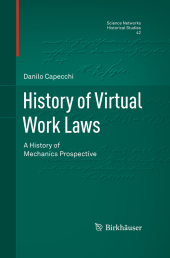 Neuerscheinungen 2016Stand: 2020-02-01 |
Schnellsuche
ISBN/Stichwort/Autor
|
Herderstraße 10
10625 Berlin
Tel.: 030 315 714 16
Fax 030 315 714 14
info@buchspektrum.de |

Danilo Capecchi
History of Virtual Work Laws
A History of Mechanics Prospective
Softcover reprint of the original 1st ed. 2012. 2016. xii, 492 S. 30 Tabellen. 235 mm
Verlag/Jahr: SPRINGER, BERLIN; SPRINGER MILAN; SPRINGER 2016
ISBN: 8847039142 (8847039142)
Neue ISBN: 978-8847039148 (9788847039148)
Preis und Lieferzeit: Bitte klicken
This book presents a history of classical mechanics, documenting methods of study from Greece in the fourth century BC to late nineteenth-century Europe. The text assesses effectiveness of forces based on the virtual motion of their points of application.
The book presents a history of classical mechanics by focusing on issues of equilibrium. The historical point of view adopted here restricts attention to cases where the effectiveness of forces is assessed on the basis of the virtual motion of their points of application. For completeness, hints of the alternative approach are also referred, the Archimedean for ancient mechanics and the Newtonian for modern mechanics. The laws resulting from consideration of virtual motions are named laws of virtual work. The modern formulations of the principle of virtual work are only a particular form of them.
The book begins with the first documented formulations of laws of virtual work in the IV century BC in Greece and proceeds to the end of the XIX century AD in Europe. A significant space is devoted to Arabic and Latin mechanics of Middle Ages. With the Renaissance it began to appear slightly different wordings of the laws, which were often proposed as unique principles of statics. The process reached its apex with Bernoulli and Lagrange in the XVIII century. The book ends with some chapters dealing with the discussions that took place in the French school on the role of the Lagrangian version of the law of virtual work and its applications to continuum mechanics.
Logic status of virtual work laws.- Greek origins.- Arabic and Latin science of weights.- Italian Renaissance statics.- Torricelli´s principle.- European statics during the XVI and XVII centuries.- The principle of virtual velocities.- The Jesuit school of the XVIII century.- Lagrange´s contribution.- Lazare Carnot´s mechanics of collision.- The debate in Italy.- The debate at the Ecole polytechnique.- Poinsot´s criticism.- The treatises of mechanics.- Virtual work laws and continuum mechanics.- Thermodynamical approach.
From the reviews:
"The book under review is a survey work that covers the whole span of history from antiquity to the middle of the nineteenth century ... . a substantial contribution to the history of physical science and will become a standard reference source for the history of mechanics. ... Throughout the book there are quotations and passages from primary sources, translated into English. ... The bibliography contains extensive references to the secondary literature ... ." (Craig G. Fraser, Mathematical Reviews, June, 2013)


